DIY Boatyards
In response to your recent request for good DIY boatyards: Berkeley Marine Center in (where else?) Berkeley, Calif., offers the best of both worlds. It allows and encourages do-it-yourselfers to handle their work, but the knowledgeable and friendly staff headed by Cree Partridge and the yard manager, Karl, are available for consultation or pulling the proverbial horse out of the ditch when you have bitten off more than you can chew.
John T. Sutton
Islander 36
Toronto, Ontario
Thanks to everyone who responded to our call for suggested DIY boatyards for an upcoming article. There is still time to participate: Send your picks to the editors e-mail at practicalsailor@belvoirpubs.com. If you didnt hear from us on this topic, its probably because youre not getting the editors e-newsletter, which represents his very best efforts at 3 a.m. the night before deadline. To sign up, go to:
www.practical-sailor.com/customer_service/ and select “Change My E-mail Address.”Autopilot Survey
We are buying an autopilot for our Bayfield 32c and read the relevant Practical Sailor articles with interest. We plan to go with a Raymarine direct drive (belowdecks) unit. Do you have an opinion about whether the new Raymarine X10 series is a truly substantial improvement over the S1 series? The West Marine rep says it will be hugely better, more than worth the extra $1,500 in terms of accuracy and reliability. But boats I have been on with the S1 seem to do fine. If you have had a chance to see the units and have an opinion, we would (as always) be very interested in your thoughts.
David Nicklin
Bayfield 32
Via e-mail
Unfortunately, we have not yet had the chance to take a good look at the new computer processing units (CPUs), or “brains,” that the various autopilot makers are unveiling. As with their predecessors, these new units tout an improved ability to learn how to steer the boat in various conditions. Its been 11 years since we last did a comprehensive review of belowdecks autopilots, so another study is long overdue. Based on past experience, input from the field, and previous testing, the
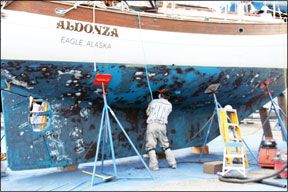
288
weakest link in autopilots-given a proper installation-is generally the drive unit. No matter how adaptive or smart an autopilot guidance system is, it is still limited by the power, response time, and ruggedness of the drive unit. A popular choice for original equipment on production cruising boats, Raymarine has a large share of this market. B&G and Simrad (formerly Robertson), both now under the Navico umbrella, also claim highly adaptive CPUs and have a loyal following among racers and performance cruisers. Alpha and ComNav also have a slice of this field. Garmin does not yet have an entry, but it recently purchased a highly rated powerboat autopilot, the Nautimatic TR-1. One unit that consistently gets high marks from ocean voyagers and commercial fishermen is WH Autopilots in Bainbridge Island, Wash., which relies more on a robust drive apparatus and user input than on adaptive steering algorithms. Part 1 of our last comparison, now posted online under “Tools and Techniques” at
www.practical-sailor.com, offers some good background on selecting gear. Readers can help with our autopilot review by voicing their opinion on particular pilots-tiller, wheel, or belowdecks-in an e-mail survey available by writing practicalsailor@belvoirpubs.com. Please put “autopilot survey” in the subject line.Why the Navy 44?
As a long-term subscriber, Id simply like to say that the boat review of the Navy 44 MkII in your August 2008 issue was a total waste of time, paper, and ink. At best, the subject might have merited a “gee wiz” one-page overview, but to waste six pages on a boat that none of your readers will ever own is to drift away from your mission which I thought was to “be practical.”
Jim Schofield
Almost Heaven, Sabre 34
Chesapeake Beach, Md.
In the wake of our analysis of common hull failure points in recreational boats (August 2007), the editors felt that a closer look at the Navy 44MkII was due. As mentioned in the article, the boat, particularly in terms of construction and safety
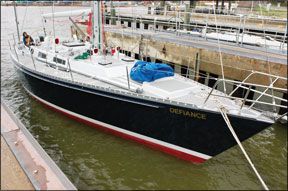
Photo by Ralph Naranjo
288
details, can serve as a useful baseline for judging production-quality new or used boats. For example, the hull material study carried out by Ensign M.H. Arvidson and Assistant Professor of Naval Architecture Paul Miller
http://web.usna.navy.mil/~phmiller/Impact_study.pdf) offers some insight into the strengths and weaknesses of composite construction, data that owners (and builders) of boats with cored hulls, such as your Sabre, can use. Certainly, there is no ideal boat by which all others can be measured, but the Navy 44 offers a good starting point.
No, there are no Navy 44MkIIs on the market, but David Pedricks plans for the boat are available to anyone who wants to commission one, and a production version is not out of the question.
Medical Kits
I am enjoying your series on medical kits. I think that it is very informative and provides a baseline for what should be the content of various kits. My question is whether buying a kit saves money, or if it is cheaper to go to a well-stocked drug store and as necessary a medical supply house using one of your lists.
Dennis Budzik
Via e-mail
We have generally found that you will save money, even when you add the cost of a good watertight container. If you want to stock your own case, wed start with the Oceanmedix book by Dr. Weiss and Michael Jacobs, available at
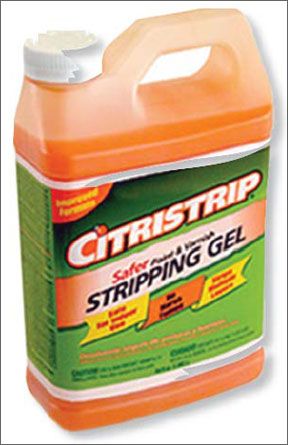
288
www.oceanmedix.com
. Dr. Peter Eastmans “Advanced First Aid Afloat,” now in its fourth edition, also devotes chapters to the ships medicine chest. One advantage of packing your own kit is that you are familiar with its contents and how it is organized.Citristrip
Regarding your recent discussion of removers for varnish and wood treatments: We have used Citristrip with great success. It did not harm the gelcoat, smelled great, and is biodegradable. One thick coat, kept moist for an hour and removed with a plastic putty knife, removed almost all Cetol; a second coat finished the job. We found another orange-based product, d-Limonene. It works like magic as a cleaner when diluted in water, and is the main ingredient in many commercial orange cleaners. Straight out of the bottle, it dissolves any adhesive, and it even removes wine stains. We found it at www.citrusdepot.net.
Chauncey Chapman
Island Packet 32
San Francisco, Calif.
Lighthouse Windlass
I just received your October 2008 issue and noted that in the cover photo, you featured what I consider the best 12-volt windlass for a world-cruising sailboat: the Lighthouse 1501. I was surprised that in your article, you did not mention, nor provide the contact for Lighthouse.
The Lighthouse 1200 has been standard equipment on Valiant sailboats for years and is successfully pulling up heavy chain rodes on Valiants all over the world. The
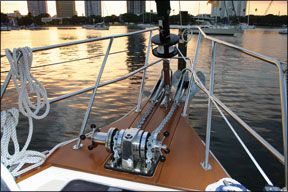
288
experience of Valiant owners is best expressed by the observation on the Valiant Owners blog: “If your Lighthouse Windlass isn’t working, you must have forgotten to turn on the power.” The Lighthouse website is www.lighthouse-mfg-usa.com, where you can obtain more information on this bulletproof stainless windlass.
Ardell Hoveskeland
Valhalla, Valiant 42
Annandale, Va.
Indeed, the Lighthouse Windlass has a well-deserved reputation as a reliable workhorse. We regret that reference to the brand and contact information inadvertently wound up in the recycle bin.
Preserving Varnish
Regarding your tips to preserving partially used containers of varnish (Mailport, October 2008), I have had good luck with preserving paint by floating a piece of ordinary kitchen plastic wrap on the surface, then re-closing the container, thus keeping air away from the contents. Paint stored this way has remained good for years. Some solvents may react with the plastic, so it may be worth testing a sample first.
Stephen R. Troy
Rainbow 24
Arnold, Md.
Saving Paint
Parte DeuxRegarding your recent advice on preserving paints and varnishes, heres something I learned too late in life. First, after opening a new can of paint, using a simple hammer and nail, punch three or four holes in the recessed lip of the can. This will allow the paint to drain back into the can as you use it and will keep the top clean.
Second, and most important, after using the paint, and after you firmly press the lid back on the can, ALWAYS turn the can over for about 10 seconds or so. This will allow the paint in the can to seal it. (I have kept 2 inches of paint in a gallon can fresh for years using this technique.)
Jim Ellison
Passport 51.5
Mamaroneck, N.Y.
10-Year Bottom Coating?
I am looking for a long-lasting effective bottom paint. I have just re-read your report on bottom paints (October 2008). I found it very informative and had almost made a selection when I heard about Coppercoat bottom paint (www.coppercoat.com). Their claim is that Coppercoat is a 10-year paint. Have you any knowledge about this product?
Keith Kummerfeldt
Seattle, Wash.
We plan to include this product in our next bottom paint test, along with some other unconventional coatings. Longtime readers of
Practical Sailor may remember our tests of a similar long-life bottom coating called CopperPoxy (unrelated to Coppercoat),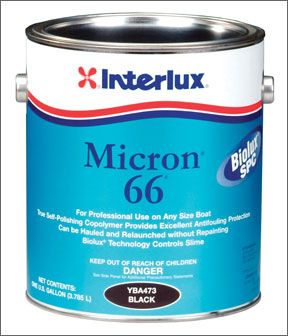
Photo by David Liscio
288
which, depending on who you spoke with, either worked great, or did no better than ordinary bottom paint. In the last report we could find (Mailport, Nov. 15, 1997), CopperPoxy was doing OK after four seasons in New England on one of our test boats, but it required regular sanding and was not as effective as the better bottom paints. The coating, as far as we know, is no longer around.
MOB for Singlehanders
Your test of MOB beacons (July 2008) called to mind an ad I saw in a marine publication (I can’t recall which one) more than a year ago, advertising a unique man-overboard device designed specifically for solo sailors to wear or carry. If you went overboard, you could push a single button on the powerful device and the boats autopilot would turn the boat dead into the wind, effectively stopping the boat and giving the sailor a fighting chance to swim to the boat and climb onboard. Naturally, I never saw the product advertised again, and no one I know has ever heard of it. Did I dream this?
Steven Fink
Rondo, Beneteau 423
Marina del Rey, Calif.
The MOBi-lert 720i and other MOB devices afford a switching function that could shut off an autopilot, turn off an engine, set off a distress call, etc., but automatically steering into the wind is a bit of stretch. Keep in mind that in a breeze over 10 knots, most boats will move faster than a swimmer, even when backwinded and no one is at the helm. Wed focus our energies on not falling overboard, rather than how to self-rescue. The tales of a solo sailor turned swimmer catching up to the boat and getting back aboard are few.
Swan 43 Tough Boat
Please add the Nautor Swan 43, designed by Sparkman & Stephens and brought to the U.S. as the PJ Swan 43, to your list of well-built “tough” fiberglass boats. I own hull no. 38, originally commissioned for Stuart Greene in 1970 as Dove. Stuart told me that following an SORC race, on the way back to Florida, they ran up on a reef off the coast of Cuba. The boat was abandoned, and he and the crew were “interned” by Castros police for two weeks. After being released, he inquired about the boat. He was taken to a harbor, where the boat was found floating on her lines. When he inquired as to how this could be, he was told that a crew had taken hammers, sledgehammers, and crowbars and broken up the reef until the boat floated free. (Apologies to environmentalists.) She was towed to shore. The only damage was a significant gash to a substantial V-shaped stainless steel “shoe” attached to the bottom of the lead keel. They sailed her home. Mitch Neff, who was a neighbor of mine near Chestertown, Md., confirmed this account when he examined the boat shortly after I acquired her. He had campaigned with Stuart in the early 1970s.
Michael Macielag
Katyushka, Swan 43
Chestertown, Md.


































